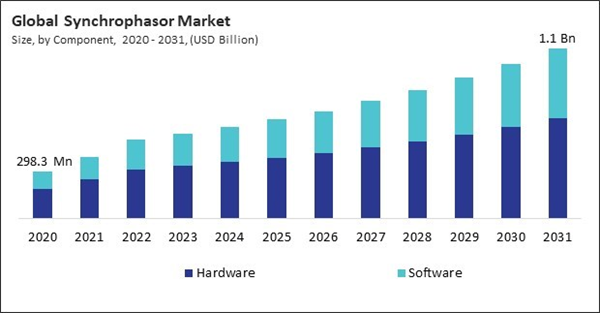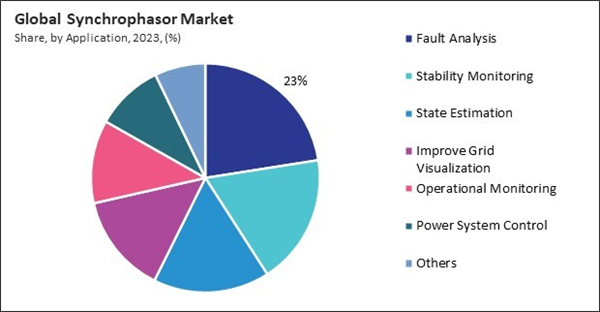The Global Synchrophasor Market size is expected to reach $1.1 billion by 2031, rising at a market growth of 9.3% CAGR during the forecast period.
Synchrophasor technology enables utilities to detect and analyze faults in the electric grid in real-time. Thus, the fault analysis segment acquired 22% revenue share in the market 2023. Fault analysis capabilities provided by synchrophasors allow grid operators to quickly identify the location, type, and severity of faults such as short circuits, line faults, and equipment failures. This rapid detection facilitates faster response times for restoring grid stability and minimizing the impact of disruptions on electricity supply.
Many existing electrical grids are outdated, built decades ago without the capacity to handle modern demands. This leads to inefficiencies, higher maintenance costs, and increased risk of failures. As aging power grid infrastructures need upgrades, grid modernization efforts aim to improve efficiency, reliability, and sustainability.
Moreover, rapid service restoration is critical during power outages to minimize economic losses and customer inconvenience. Synchrophasors facilitate quicker identification of outage locations and assessment of grid stability post-outage. Thus, rising power outages and blackouts drive the market's growth.
However, Synchrophasors require substantial capital investment for deployment and installation. The costs involve not only purchasing the synchrophasor units themselves but also integrating them into existing grid infrastructure. Therefore, the high initial costs of synchrophasors hinder the market’s growth.
Synchrophasor technology enables utilities to detect and analyze faults in the electric grid in real-time. Thus, the fault analysis segment acquired 22% revenue share in the market 2023. Fault analysis capabilities provided by synchrophasors allow grid operators to quickly identify the location, type, and severity of faults such as short circuits, line faults, and equipment failures. This rapid detection facilitates faster response times for restoring grid stability and minimizing the impact of disruptions on electricity supply.
Many existing electrical grids are outdated, built decades ago without the capacity to handle modern demands. This leads to inefficiencies, higher maintenance costs, and increased risk of failures. As aging power grid infrastructures need upgrades, grid modernization efforts aim to improve efficiency, reliability, and sustainability.
Moreover, rapid service restoration is critical during power outages to minimize economic losses and customer inconvenience. Synchrophasors facilitate quicker identification of outage locations and assessment of grid stability post-outage. Thus, rising power outages and blackouts drive the market's growth.
However, Synchrophasors require substantial capital investment for deployment and installation. The costs involve not only purchasing the synchrophasor units themselves but also integrating them into existing grid infrastructure. Therefore, the high initial costs of synchrophasors hinder the market’s growth.
Driving and Restraining Factors
Drivers- Grid modernization and rise of smart grids
- Rising incidences of power outages and blackouts
- Increasing demand for electricity worldwide
- High initial costs synchrophasors
- Data management challenges
- Growing integration of renewable energy
- Regulatory support and compliance
- Limited awareness and lack of expertise
- Increasing competition from alternative technologies
Application Outlook
By application, the market is segmented into fault analysis, state estimation, stability monitoring, power system control, operational monitoring, improving grid visualization, and others. In 2023, the stability monitoring segment procured 18% revenue share in the market. Stability monitoring provides utilities with enhanced situational awareness of dynamic grid conditions and disturbances.Component Outlook
Based on component, the market is divided into hardware and software. The software segment attained 37% revenue share in the market in 2023. Hardware components such as synchrophasor measurement units (PMUs) and sensors are fundamental for collecting synchronized electrical quantities measurements across different grid points.Regional Outlook
Region-wise, the market is analyzed across North America, Europe, Asia Pacific, and LAMEA. In 2023, the Asia Pacific region generated 27% revenue share in the market. The region is undergoing rapid industrialization, urbanization, and population growth, driving electricity demand.List of Key Companies Profiled
- Schweitzer Engineering Laboratories, Inc. (SEL)
- Arbiter Systems, Inc.
- Vizimax Inc.
- Powerside
- ERLPhase Power Technologies Ltd.
- ABB Ltd.
- Siemens AG
- General Electric Company
- NR Electric Co., Ltd. (NARI Technology Development Limited Co.)
Market Report Segmentation
By Component- Hardware
- Software
- Fault Analysis
- Stability Monitoring
- State Estimation
- Improve Grid Visualization
- Operational Monitoring
- Power System Control
- Others
- North America
- US
- Canada
- Mexico
- Rest of North America
- Europe
- Germany
- UK
- France
- Russia
- Spain
- Italy
- Rest of Europe
- Asia Pacific
- China
- Japan
- India
- South Korea
- Singapore
- Malaysia
- Rest of Asia Pacific
- LAMEA
- Brazil
- Argentina
- UAE
- Saudi Arabia
- South Africa
- Nigeria
- Rest of LAMEA
Table of Contents
Chapter 1. Market Scope & Methodology
Chapter 2. Market at a Glance
Chapter 3. Market Overview
Chapter 4. Global Synchrophasor Market by Component
Chapter 5. Global Synchrophasor Market by Application
Chapter 6. Global Synchrophasor Market by Region
Chapter 7. Company Profiles
Companies Mentioned
- Schweitzer Engineering Laboratories, Inc. (SEL)
- Arbiter Systems, Inc.
- Vizimax Inc.
- Powerside
- ERLPhase Power Technologies Ltd.
- ABB Ltd.
- Siemens AG
- General Electric Company
- NR Electric Co., Ltd. (NARI Technology Development Limited Co.)
Methodology

LOADING...










